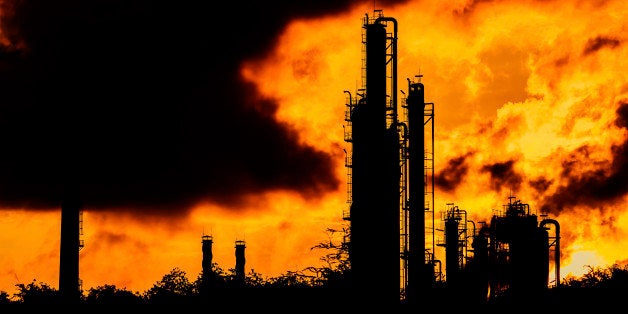
The fight over Uber can be reduced by the media in a place like New York City as a fight between hide-bound yellow cabs and high-tech Uber "innovators"--but that's a frame that ignores the more than 95% of the population that don't use any kind of cab at all. And when you take a step back, the fight over Uber and its future likely use of driverless cars has enormous implications for whether our nation and the world can stop climate change from killing the planet.
When a deal was announced Wednesday for Uber to continue growing, but sharing its data with the city for a study on its effects on transit in the City, a key part of the deal was that not only would the City be studying how Uber impacts the traffic patterns, jobs and the effects on disabled drivers, it would be looking at how Uber will share revenue to strengthen mass transit for the rest of the City's population.
Whither the Green Metropolis?
And the impact of Uber and ultimately driverless cars on mass transit is exactly what any study of Uber should be focusing on, both for the needs of the mass of consumers who depend on it and for how more cars on the roads in New York City could undermine the fight against climate change.
A core reality is that most New Yorkers do more to fight climate change just by living here than most of the crunchiest Green-oriented consumers living in the suburbs largely because they don't drive cars. This isn't a small difference. Studies show that New York City residents use only one-third of the energy per capita of the average American consumer. To put it another way, every million people living in NYC is equivalent to shutting down 15 coal-powered power plants.
So the long-term question is how Uber and driverless car will impact mass transit and energy use in the mass transit system that now makes New York City the "green metropolis" of the nation?
The Debate on the Environmental Impact of Driverless Cars
Uber has made it clear that, for all their propaganda about creating jobs, their goal is to eliminate taxi drivers altogether in favor of driverless cars. "The reason Uber could be expensive is because you're not just paying for the car -- you're paying for the other dude in the car," CEO Travis Kalanick said at a conference last year. "When there's no other dude in the car, the cost of taking an Uber anywhere becomes cheaper than owning a vehicle." In Pittsburgh, Uber has opened a driverless car research center to move this goal forward and has test vehicles out on the streets of that city already.
Now, if Tesla and Google deliver electric-driverless cars, won't such Uber services be an environmental bonanza? Some researchers have argued this exact position, but they have to assume that current coal-driven and other polluting power plants delivering the electricity to power those cars will be far less polluting than they are today. In fact, many analysts have noted that today's electric cars often contribute more carbon emissions to the environment than a typical gasoline-powered car, since not only do they often draw electricity from dirtier power sources than gasoline, there are additional energy costs in charging the batteries and, more significantly, in the complex manufacturing of the batteries themselves. How polluting electric cars are is hotly debated, but they are no panacea at the moment.
Driverless cars create the additional environmental danger of increasing the number of car trips and miles cars drive. A study at the University of Michigan this year argued that driverless cars will inevitably use more fuel than cars with drivers because they will encourage those extra trips. For cars owned by individuals, it will be attractive for families to skip combining trips and instead have the car drop Dad off at work, come open empty to pick up Mom, and even potentially add separate trips for older kids.
Translate a similar analysis to a place like New York City and you have the fear that large numbers of energy-efficient subway trips get replaced with polluting Uber taxi rides. Data shows that Uber has already increased congestion in downtown Manhattan, so it's hard to believe that the promise of "cheaper" driverless rides won't explode that congestion in the future.
As importantly, the "convenience" of taxi trips will likely encourage more poorly designed transit corridors in New York City and across the country, encouraging new housing in expanded urban sprawl - the core source of climate change pollution. The issue of Uber and expanded driverless cars is not just about how they might make driving today more convenient, but whether they are just a way to avoid the broader planning and infrastructure investments to fix long-term problems in our transit systems.
Mass Transit is the Real Innovator, Not Silicon Valley
Mass transit has been having a slow but steady revival in this country as the number of vehicle miles driven per person has been dropping significantly since 2005. Uber, Tesla and Google are promising a driverless car "fix" for transit issues, a solution that is attractive for many politicians precisely because it demands few new public dollars or the hard decisions needed to change environmentally destructive (and racially segregated) housing and transportation development patterns in our nation.
That a taxi-hailing app is an important "disruptive innovation" is a distraction from the serious failure of the U.S. to invest significant dollars in transportation infrastructure, particularly new transit that is less polluting. The World Economic Forum's Global Competitiveness Report ranks the U.S. 15th in quality of its rail system and 16th in quality of its roads--and public investment in infrastructure has continued to fall in the last few decades.
Compare this to China where the government has announced plans for major investments to unite a region of 130 million people in the Beijing region with new high-speed rail lines, new subway systems to replace dysfunctional highways, and better connections between small and larger cities to make it possible to get across the region rapidly for all families. Between 2008 and 2010, the government approved $654 billion in investments for mass transit as part of the country's stimulus effort to fight the global financial crisis. Probably not coincidentally, as China has seen that such investments can strengthen their economy and deliver climate change emission reductions, they have become far more willing to commit to global agreements to reduce climate change.
Relative to the kind of bold investments for the future that China is now making - something that the U.S. itself was once a leader in globally - the "innovations" of Silicon Valley, like driverless cars, seem somewhat pathetic. They seem to be more of an excuse by economic and policy elites to distract the public debate away from the investments needed- and taxes on that economic elite - that could deliver real improvements in transportation for the population as a whole and the reductions in climate change emissions needed to save the planet.
Uber and driverless cars may have some niche role in supplementing transit systems across the country, but as New York City studies their likely impact, we can hope that the City follows through on ensuring that they contribute significantly to expanding the mass transit systems that remain the all-time champion innovators in fighting climate change and delivering effective transportation for most of the population in the City.
